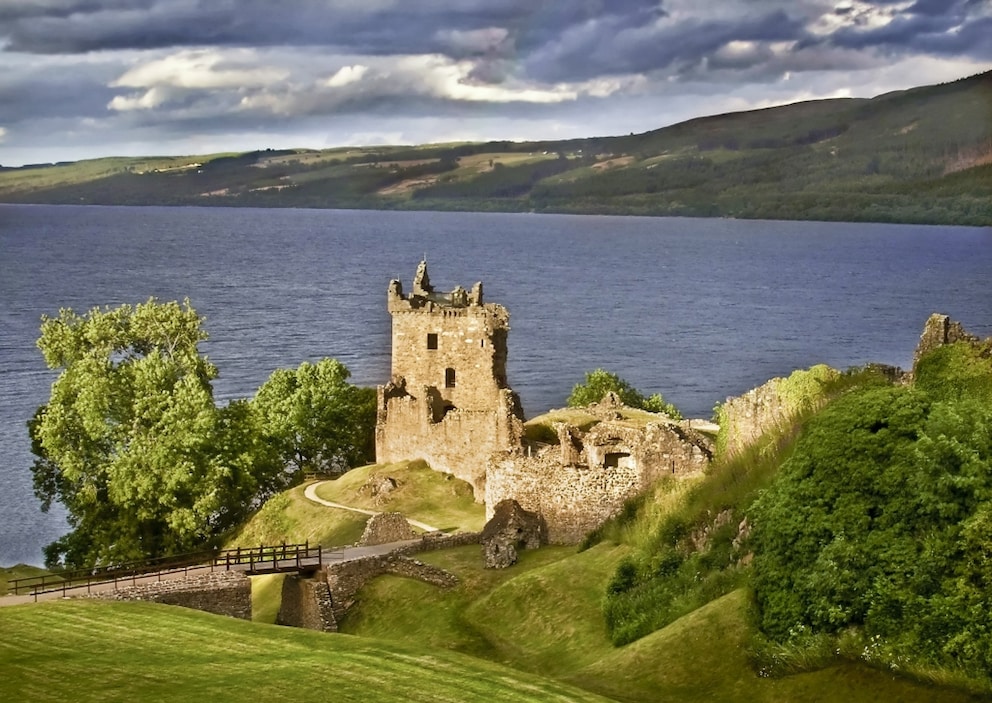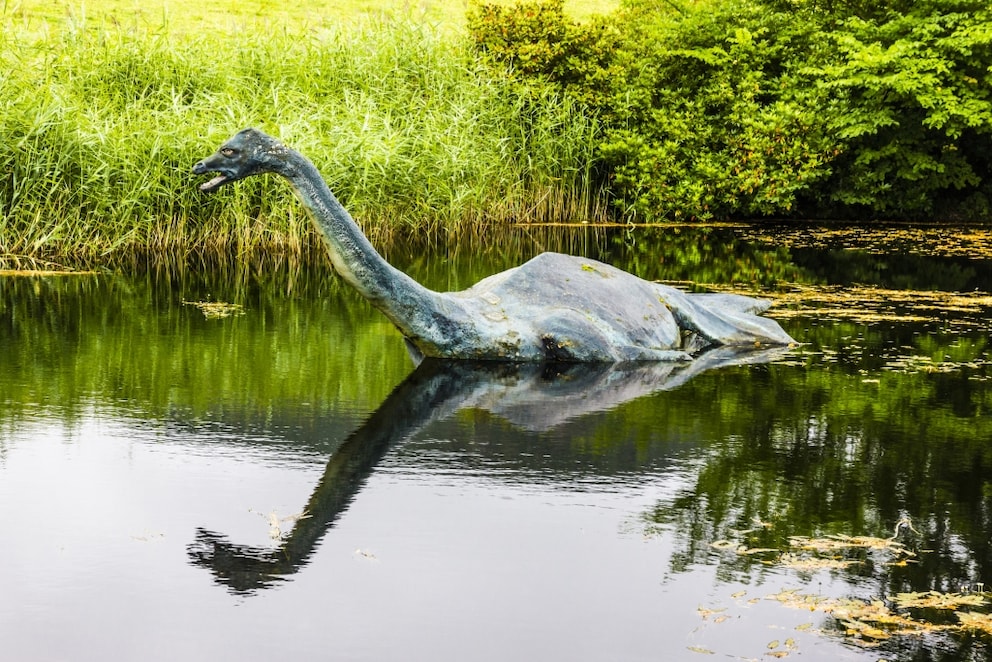September 12, 2024, 2:54 pm | Read time: 8 minutes
The huge Loch Ness in the Scottish Highlands is world-famous. The reason is not just the beautiful giant lake itself, but its supposed inhabitant: Nessie. The Loch Ness sea monster has been drawing crowds to the Scottish Highlands for many years. Our author, Anna Wengel (now Chiodo), has also been there. Read here how she experienced the Nessie spectacle and how you can get closer to Nessie.
I’m a little excited when the GPS tells me that we should soon be arriving at Loch Ness. Still euphoric from my visit to the Glenfinnan Viaduct this morning, I’m even more excited about the next supposed highlight of my trip to Scotland. Nessie fascinates me, like so many others, even if I don’t quite know what to make of the legend surrounding the mystical giant monster. Because, as much as I would like to believe in a dino-like animal in the deep lake, it is difficult.
Visit to Loch Ness
Passing Loch Lochy, the route has already been taking us through the fascinating nature of the Highlands for a good hour when we arrive in Fort Augustus. And thus, in the middle of the tourist hustle and bustle. The charming town is not large and on this day in August, there are parked vehicles and people in shorts and sun hats with cameras, selfie sticks, and bad weather backpacks everywhere. Everywhere there are small and large references to the sea monster that most people have probably come here to see: a wiry statue, balloons, cuddly toys and so on. Finally, I catch my first glimpse of the world-famous lake, which is up to 230 meters deep and, incidentally, is the lake with the greatest volume of water in Great Britain.
We continue along the huge blue loch and enjoy the tranquil scenery of dense, green forests, partly rocky cliffs to the left, and the calm of this seemingly never-ending inland lake. Of course, every now and then, I keep an eye out to see if there isn’t a neck sticking out of the water to prove to us that the myths are true. But the loch remains calm, beautiful, and peaceful.
Too much Nessie tourism
On our way to our accommodation near Inverness that day, I had set my sights on the Loch Ness Center. But when we arrive, I feel aversion spreading through me. I’m sure there are all sorts of exciting things to see and experience here. But to be honest, the Nessie theme just seems overblown to me here too, and not just because of the various Nessie figures everywhere. The situation is similar two days later in Inverness, where my daughter is allowed to choose a Nessie cuddly toy but has to choose from a huge variety of Nessies. Loch Ness is world-famous, and of course people come here to see it, and of course this is catered to accordingly. But it’s too much for me. Too much Nessie tourism. And I spontaneously change my mind and don’t go back to the lake and its various Nessie sites.
Does that mean I would advise against visiting Loch Ness? No, by no means. Not only do I think that other tourists will certainly find the Nessie spectacle super exciting. There is simply a lot to see, read and discover. But above all, Loch Ness itself, sea monster or not, is simply very beautiful. Although pretty much all the other lochs I’ve passed in Scotland are, that doesn’t mean you should avoid this one. Even without the Nessie tourism, there are many places on the huge loch where you can enjoy the view of the water in peace without being jostled aside by hundreds of other tourists.
Nessie has many relatives in Scotland
Finally, I found a conversation I had with our Scottish B&B host fascinating: he told me that there are various other lochs in Scotland where there have been sightings similar to that of Nessie, some even more credible. He explained to me that the sighting of the supposed Loch Ness monster was caused by gases in the water that depended on the water temperature. These gases would push huge tree trunks out of the water in such a way that people may have mistaken them for a giant neck.
Following the interview and in preparation for this article, I did a bit of research into both topics. And it’s true that various Scottish lochs are said to be home to quasi-relatives of the Loch Ness monster, including Lizzie in Loch Lochy, for example. On the official Nessie sightings page, I find my host’s statement confirmed. It says: “Like many other Scottish lochs, Loch Lochy has a history of monster sightings.” Another, for example, is Mhorag or Maggie, a plesiosaur-like monster, like Nessie, that supposedly lives in Loch Morar.
But are they really all just tree trunks? The website “visitinvernesslochness” supplements this theory with other, partly scientific explanations: wave-like boat waves, mirages that make long-necked water birds appear larger, gusts of wind, seals, deer swimming in the loch, wild animals swimming, and eels. The list is long, although not as long as the alleged sightings of the supposed lake monster. Nessie is said to have been seen more than 1,140 times in one form or another. Whether it can ever be conclusively clarified who lives in Loch Ness is unclear. And maybe that’s just as well.
Also interesting: ‘Why the Highlands are a place of longing for me, as well as a seafood paradise’
5 popular Nessie search locations
If you want to go in search of the Loch Ness monster, you can start with these first options:
1. Urquhart Castle
The castle on the western shore of the loch is considered a good place to start your hunt for Nessie. Most alleged sightings have taken place around the ruins. According to experts, this is also due to the fact that the deepest part of the lake is very close by. With its strategic position roughly in the middle of Loch Ness, the castle also offers a good view in all directions. Once a mighty fortress to secure English rule over the Scottish Highlands, Urquhart Castle changed hands frequently, especially in the Middle Ages. In 1692, the castle was finally abandoned and fell into disrepair. For adults, admission costs 13 pounds (around 15.40 euros) if purchased online in advance.

2. Drumnadrochit
The small village near Urquhart Castle is the center of Nessie tourism. Here, the interactive Loch Ness Centre (adults: 18.95 pounds, equivalent to 22.45 euros; children: 15.45 pounds, 18.30 euros) and Nessieland (adults pay 8 and children 6 pounds, equivalent to 9.48 and 7.11 euros) provide information about the loch’s most famous inhabitant. The latter professes to want to keep the myth alive. Scientific evidence against the existence of Nessie is not to be expected here. In the town center, tours and hotels can be booked at the Loch Ness Hub & Travel Information Center.

3. A boat trip on Loch Ness
Hunting for the sea monster on the loch itself is another idea, and several operators run tours of Loch Ness. In the north-west, Jacobite Cruises caters to larger groups and can accommodate up to 300 Nessie fans. In the far south, in Fort Augustus, the medium-sized ships of Cruise Loch Ness depart. If you want something a little quieter, contact Mike Bell in Drumnadrochit. He takes up to twelve people on the “Nessie Hunter” several times a day.
4. A real “Nessie hunter”
Anyone who has seen Nessie or wants to hear first-hand stories about the monster should visit Steve Feltham. The 60-year-old holds the Guinness World Record for the longest uninterrupted search for Nessie: more than 32 years ago, Feltham moved to the beach at Dores on the north-east corner of the lake. He earns his living by selling homemade Nessie figurines (about 9 pounds).

5. Walks around Loch Ness
Loch Ness is difficult to access in many places, partly because the banks fall away steeply. A good overview is provided by “walks“, which are marked hikes. Some, such as the ascent of Meall Fuar-mhonaidh on the west side, is the highest mountain on the loch at 699 meters, and more strenuous. On the east side of Loch Ness, steep steps lead to the Foyers waterfall, from where you can descend to the shore. Much more relaxing is a walk from Dores along the shingle beach to the forest of the Aldourie Estate with its picturesque castle on the loch. If you want more, you should hike the 360-degree trail: once around the lake. At around 130 kilometers, however, you should allow some time.

‘Why the Highlands are a place of longing for me, as well as a seafood paradise’

‘Why the Glenfinnan Viaduct Is One of My Scotland Highlights’

‘Why I probably won’t be going to Aberdeen again’
Tips for getting there
The starting point for many Nessie searches is the city of Inverness. There are no direct flights from Germany, but there are from London, Manchester, Amsterdam, and other cities. Buses run from Inverness to Drumnadrochit and Fort Augustus. There are also train connections to Inverness, for example, from Edinburgh or London.
However, it is also worth booking a rental car to explore Inverness, Loch Ness, and the surrounding area. It takes around three and a half hours by car from Edinburgh to Loch Ness.
Also interesting: “I immediately fell in love with Scotland’s capital, Edinburgh
With material from dpa

